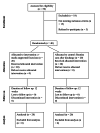Effects of an e-Media-Supported, Exercise-Based Phase II Cardiac Rehabilitation in Coronary Artery Bypass Grafting Surgery Patients: A Randomized Controlled Trial
- PMID: 39314565
- PMCID: PMC11417418
- DOI: 10.7759/cureus.67557
Effects of an e-Media-Supported, Exercise-Based Phase II Cardiac Rehabilitation in Coronary Artery Bypass Grafting Surgery Patients: A Randomized Controlled Trial
Abstract
Background and objective Coronary artery bypass grafting (CABG) surgery patients undergo cardiac rehabilitation (CR) programs postoperatively to improve their course of recovery. The effectiveness of traditional CR programs is hampered by time constraints, financial burdens, transportation issues, and geographic restrictions. The coronavirus 2019 (COVID-19) pandemic and technological advances have led to the emergence of home-based CR programs using e-media, thereby improving accessibility. This study aimed to analyze the effects of e-media-supported, exercise-based phase II CR in post-CABG patients. Methods A single assessor-blinded randomized controlled trial (RCT) was conducted at a tertiary care hospital to analyze the effectiveness of a validated e-media-supported, exercise-based phase II cardiac rehabilitation in CABG Patients. A total of 40 subjects were included in the study based on the inclusion and exclusion criteria. The subjects were then randomly assigned to two groups: the experimental group received e-media-supported exercise and the control group received routine care. The duration of the intervention was three months. The outcome measures used were functional capacity, left ventricular ejection fraction (LVEF), quality of life, and physical activity (PA). Statistical analysis was conducted using SPSS Statistics v. 22.0 (IBM Corp., Armonk, NY). Results After three months of intervention, the mean distance covered during the six-minute walk test (6MWT) showed a significant increase in both the control and experimental groups. The experimental group demonstrated a statistically significant improvement compared to the control group (p<0.001). Furthermore, the experimental group showed significant improvements in the rate of perceived exertion (RPE), LVEF, and World Health Organization Quality of Life Brief Version (WHOQOL-BREF) and Global Physical Activity Questionnaire (GPAQ) scores compared to the control group (all p<0.001). Conclusions Based on our findings, the e-media-supported, exercise-based phase II cardiac rehabilitation is feasible and safe, and significantly improved functional capacity and enhanced quality of life. The PA level of the experimental group was higher than controls at the 12-week follow-up after CABG.
Keywords: cad: coronary artery disease; coronary artery bypass grafting(cabg); e-media supported exercise; exercise adherence; functional capacity; quality of life; telerehabilitation.
Copyright © 2024, Kumar R et al.
Conflict of interest statement
Human subjects: Consent was obtained or waived by all participants in this study. Institutional Ethics Committee (for Non-UG & PG Students), Sri Ramachandra Institute of Higher Education and Research issued approval CSP/23/AUG/135/775. Animal subjects: All authors have confirmed that this study did not involve animal subjects or tissue. Conflicts of interest: In compliance with the ICMJE uniform disclosure form, all authors declare the following: Payment/services info: All authors have declared that no financial support was received from any organization for the submitted work. Financial relationships: All authors have declared that they have no financial relationships at present or within the previous three years with any organizations that might have an interest in the submitted work. Other relationships: All authors have declared that there are no other relationships or activities that could appear to have influenced the submitted work.
Figures
Similar articles
-
[The comparative analysis of the influence of the supervised exercise training and home-based exercise training on the psychological status of the following coronary artery bypass grafting].Vopr Kurortol Fizioter Lech Fiz Kult. 2017 Dec 28;94(6):10-17. doi: 10.17116/kurort201794610-17. Vopr Kurortol Fizioter Lech Fiz Kult. 2017. PMID: 29388927 Clinical Trial. Russian.
-
Erratum.Mult Scler. 2016 Oct;22(12):NP9-NP11. doi: 10.1177/1352458515585718. Epub 2015 Jun 3. Mult Scler. 2016. PMID: 26041800
-
Effectiveness of nurse-led cardiac rehabilitation programs following coronary artery bypass graft surgery: a systematic review.JBI Database System Rev Implement Rep. 2018 Dec;16(12):2304-2329. doi: 10.11124/JBISRIR-2017-003565. JBI Database System Rev Implement Rep. 2018. PMID: 30204710
-
Cost-effectiveness of Cardiac Telerehabilitation With Relapse Prevention for the Treatment of Patients With Coronary Artery Disease in the Netherlands.JAMA Netw Open. 2021 Dec 1;4(12):e2136652. doi: 10.1001/jamanetworkopen.2021.36652. JAMA Netw Open. 2021. PMID: 34854907 Free PMC article. Clinical Trial.
-
A Comparison Between Cardiac Telerehabilitation Program and Outpatient Hospital-Based Cardiac Rehabilitation Program for Patients Undergoing Coronary Artery Bypass Graft (CABG) Surgery: A Review.Cureus. 2023 Nov 8;15(11):e48488. doi: 10.7759/cureus.48488. eCollection 2023 Nov. Cureus. 2023. PMID: 38073989 Free PMC article. Review.
References
-
- Coronary artery bypass graft surgery complications: a review for emergency clinicians. Montrief T, Koyfman A, Long B. Am J Emerg Med. 2018;36:2289–2297. - PubMed
-
- Early discharge after coronary artery bypass graft surgery: are patients really going home earlier? Lazar HL, Fitzgerald CA, Ahmad T, Bao Y, Colton T, Shapira OM, Shemin RJ. J Thorac Cardiovasc Surg. 2001;121:943–950. - PubMed
LinkOut - more resources
Full Text Sources
Miscellaneous

